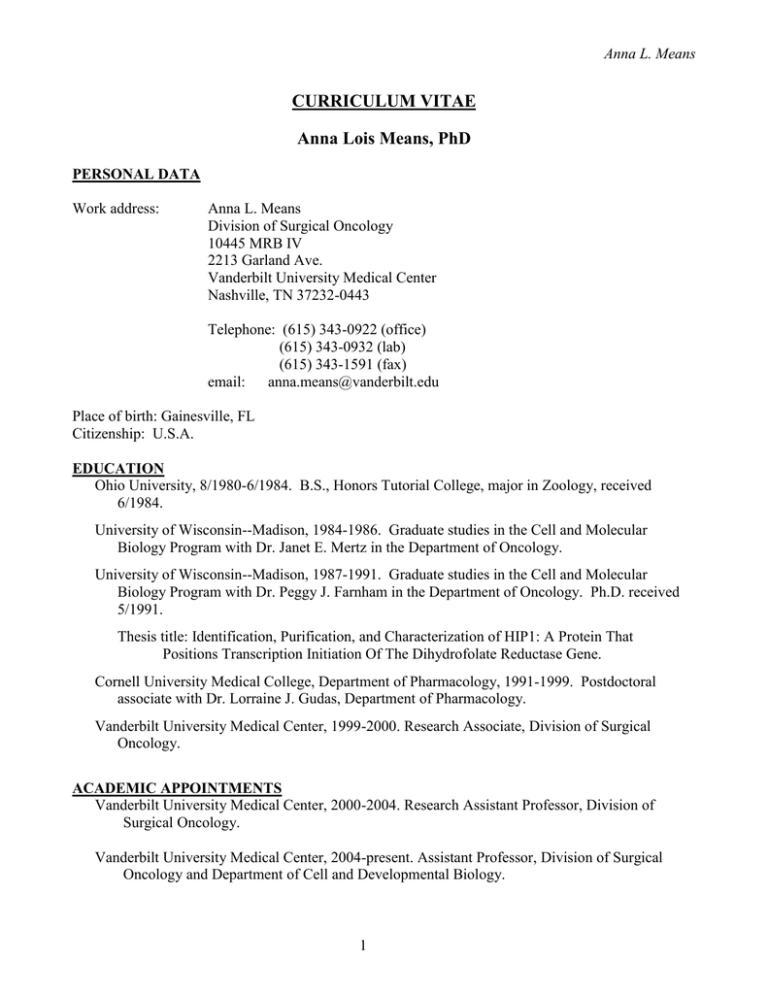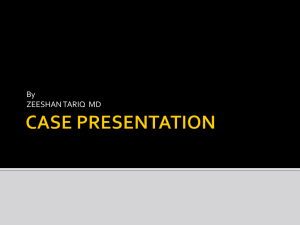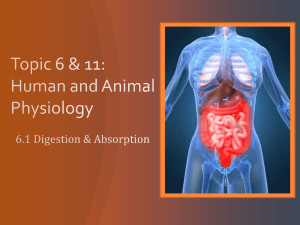CURRICULUM VITAE Anna Lois Means, PhD
advertisement

Anna L. Means CURRICULUM VITAE Anna Lois Means, PhD PERSONAL DATA Work address: Anna L. Means Division of Surgical Oncology 10445 MRB IV 2213 Garland Ave. Vanderbilt University Medical Center Nashville, TN 37232-0443 Telephone: (615) 343-0922 (office) (615) 343-0932 (lab) (615) 343-1591 (fax) email: anna.means@vanderbilt.edu Place of birth: Gainesville, FL Citizenship: U.S.A. EDUCATION Ohio University, 8/1980-6/1984. B.S., Honors Tutorial College, major in Zoology, received 6/1984. University of Wisconsin--Madison, 1984-1986. Graduate studies in the Cell and Molecular Biology Program with Dr. Janet E. Mertz in the Department of Oncology. University of Wisconsin--Madison, 1987-1991. Graduate studies in the Cell and Molecular Biology Program with Dr. Peggy J. Farnham in the Department of Oncology. Ph.D. received 5/1991. Thesis title: Identification, Purification, and Characterization of HIP1: A Protein That Positions Transcription Initiation Of The Dihydrofolate Reductase Gene. Cornell University Medical College, Department of Pharmacology, 1991-1999. Postdoctoral associate with Dr. Lorraine J. Gudas, Department of Pharmacology. Vanderbilt University Medical Center, 1999-2000. Research Associate, Division of Surgical Oncology. ACADEMIC APPOINTMENTS Vanderbilt University Medical Center, 2000-2004. Research Assistant Professor, Division of Surgical Oncology. Vanderbilt University Medical Center, 2004-present. Assistant Professor, Division of Surgical Oncology and Department of Cell and Developmental Biology. 1 Anna L. Means PROFESSIONAL ASSOCIATIONS American Association for Cancer Research Society for Developmental Biology American Society for Cell Biology American Pancreatic Association Vanderbilt-Ingram Cancer Center Vanderbilt Digestive Disease Research Center Vanderbilt Diabetes Research and Training Center Vanderbilt Program in Developmental Biology PROFESSIONAL ACTIVITIES TEACHING Molecular Developmental Biology (CDB 341) Introductory module Endodermal development, lecture and discussion, 2004-2007 Ectodermal development, lecture and discussion, 2005-2007 Branching morphogenesis module Branching morphogenesis in the pancreas, lecture and discussion, 2007 Tissue morphogenesis module, 2008 Organized 4 week module (8 classes) Invited and hosted outside speaker Led four lectures and discussion sessions Worked with other investigators to present remaining four sessions Size regulation via Hippo/Warts pathway, 2012 Organized 4 week module (8 classes) Invited and hosted outside speaker Led five lecture and discussion sections Supervised senior graduate student leading one lecture/discussion Cancer and Embryonic Development (CDB 320/CANB 320) Epithelial-mesenchymal interactions, lecture and discussion, 2007, 2009 Epithelial Pathobiology (CDB 324) Tubulogenesis lecture and discussion, 2008 RESEARCH SUPERVISION Undergraduate students: Leah McMillan, 2004, 2006 Katherine Guess, 2008 Kayla Bell, 2010 Elizabeth Moss, 2011 Katherine Lee, 2011-present Graduate summer programs: Kevin Branch, 2005. Incoming IGP student. Susan Anthony, 2005. Incoming IGP student. 2 Anna L. Means Ben Adebayo, 2008. Vanderbilt Diabetes Research Training Program for medical students Khaisha Johnson, 2010. Vanderbilt Diabetes Research Training Program for medical students Graduate student trainee: Billy J. Carver, IGP student, 2006-2008. Postdoctoral Trainee: Stacy A. Blaine, 2006-2009. Other training: Isolation and culture of primary pancreatic acinar cells: Howard Crawford (Lynne Matrisian lab), 2001 Yiannis Drosos (Beatriz Sosa-Pineda lab), 2010 Jackie Ellis (Joseph Kissil lab), 2010 Dissection and culture of embryonic pancreas: Ben Rhoades (Anil Rustgi lab), 2004 Elizabeth Tweedie Ables (Maureen Gannon lab), 2005 Michelle Guney (Maureen Gannon lab), 2007 OTHER PROFESSIONAL ACTIVITIES Vanderbilt Pancreatic Cancer Researchers (VPCR), Founder and organizer, 2010-present I brought together all those at Vanderbilt studying pancreatic cancer both at bench and at bedside for a monthly research conference. Beta Cell Interest Group, 2004-present Organizer, 2009-present, seminar series for internal investigators to report and get feedback on studies related to pancreas development and function. Beta Cell Biology Histology Core, Supervisor, 2002-2004 Supervised histology services for members of the Beta Cell Biology Consortium. Worked with investigators to plan and interpret data from this core. Pilot & Feasibility Grant Review Panel, Vanderbilt Digestive Disease Research Center, 2007-2009. NIH CIGP study section, ad hoc reviewer, 2006. Pancreatic Cancer Action Network, Nashville Chapter Volunteer, 2010-present. PENDING RESEARCH SUPPORT NIH/NCI R21 application “Kras and HB-EGF synergy in the regulation of pancreatic cancer induction” The objective of this work is to understand the role of HB-EGF signaling in Kras-initiated pancreatic cancer. 3 Anna L. Means NIH/NCI R21 application “Regulation of pancreatic cancer by the tumor microenvironment” The work proposed here develops and uses novel 3-dimensional co-culture systems and mouse models to understand how inflammatory cells and fibrotic cells regulate promotion and progression of pancreatic cancer. COMPLETED RESEARCH SUPPORT P50CA095103 (Robert J. Coffey, PI) NIH/NCI 06/01/2008 – 05/31/2010 SPORE in GI Cancer Pilot & Feasibility Award (Means, PI) The roles of Kras and EGFR signaling in pancreatic and intestinal tumorigenesis This pilot grant has enabled us to determine whether activation of a condition KrasG12D allele via the CK19-CreERT gene would allow us to investigate tumorigenesis in the pancreas or whether tumors would more quickly develop in other organs expressing CK19. 1 R01 CA98322 (Anna L. Means, PI) NIH/NCI 3/1/04 - 2/28/10 "Heparin-binding EGF in pancreatic disease" The goal of this project is to elucidate the roles of the epidermal growth factor receptor and its ligand, HB-EGF, in establishment of the pancreatic fibrosis that is associated with both chronic pancreatitis and pancreatic cancer. R21CA123061-01 (Anna L. Means, PI), NIH/NCI, 7/1/06 – 6/30/09 “The role of EGFR signaling in progression of Kras-induced pancreatic tumors” The goal of this grant is to determine the role that signaling through the epidermal growth factor receptor plays in pancreatic tumors that result from activation of Kras. These experiments use genetically engineered mice to express mutated Kras in combination with either increased or decreased EGFR signaling. JDRF 1-2006-759 (Anna L. Means, PI), Juvenile Diabetes Research Foundation 07/01/06-06/30/09 “Generating New Islets In Vivo And In Vitro” The goal of this project is define the cell of origin for the duct-associated endocrine cells that arise in association with activation of the EGF receptor. UO1 CA84239 (Robert J. Coffey, PI) NIH/NCI, 4/1/04 - 3/31/09 "Prevention and metastasis: Final frontiers in colon cancer" The goals of this grant are to understand the genetic and environmental influences on establishment and metastasis of colon cancer using mouse models. Dr. Means's role in this project is to establish mouse tumor models that have conditional deletion of tumor suppressor genes specifically in the intestinal tract and pancreas. 5P30 DK58404 (D. Brent Polk, PI) NIH/NIDDK, 6/1/02 – 5/31/07 “Molecular and Cellular Basis for Digestive Diseases” Pilot& Feasibility Study (Means, Anna L., PI), 6/1/05 – 5/31/07 “Regulation of differentiation in the embryonic pancreas” The goal of this project is to elucidate the role of EGFR signaling in early branching and differentiation of the embryonic pancreas. 4 Anna L. Means P01 DK42502 (Mark Magnuson, PI) NIH/NIDDK, 7/01/00 - 06/30/05 "Pancreatic Morphology Core, Core D, Genes of Pancreatic Function and Development" The goal of this project is to provide histological support to members of this program project grant. Dr. Means is responsible for overseeing a technician who embeds, sections, and performs immunohistochemistry. Dr. Means also provides training for members of the program project grant, and aids in planning and interpretation of histological experiments. UO1 CA84239-05 (Robert J. Coffey, PI) NIH/NCI 9/30/99 – 3/31/04 “Mouse Cancer Models via TGF- RII Loss” The goals of this project were to develop mouse models of cancer via loss of the TGF RII receptor. Dr. Means’s responsibility was to assist in the establishment and analyses of genetically altered mice that model stages of colon and pancreatic cancer. PEER-REVIEWED PUBLICATIONS 1. Farnham, P.J., and Means, A.L. 1990. Sequences downstream of the transcription initiation site modulate the activity of the murine dihydrofolate reductase promoter. Mol. Cell. Biol. 10: 13901398. 2. Means, A.L., and Farnham, P.J. 1990. Transcription initiation from the DHFR promoter is positioned by HIP1 protein binding at the initiation site. Mol. Cell. Biol. 10: 653-661. 3. Means, A.L., Slansky, J.E., McMahon, S.L., Knuth, M.W., and Farnham, P.J. 1992. The HIP1 binding site is required for growth regulation of the DHFR promoter. Mol. Cell. Biol. 12: 10541063. 4. Means, A.L. and Gudas, L.J. 1996. FGF-2, BMP-2, and BMP-4 regulate retinoid binding proteins and receptors in 3T3 cells. Cell Growth and Differentiation 7: 989-996. 5. Means, A.L. and Gudas, L.J. 1997. The CRABP I gene contains two separable, redundant regulatory regions active in neural tissues in transgenic mouse embryos. Developmental Dynamics 209: 59-69. 6. Means, A.L., Thompson, J.R., and Gudas, L.J. 2000. Transcriptional regulation of the cellular retinoic acid binding protein I gene in F9 teratocarcinoma cells. Cell Growth and Differentiation 11: 71-82. 7. Scoggins CR, Meszoely IM, Wada M, Means AL, Yang L, Leach SD. 2000. p53-dependent acinar cell apoptosis triggers epithelial proliferation in duct-ligated murine pancreas. Am J Physiol Gastrointest Liver Physiol. (5):G827-36. 8. Meszoely, I.M., Means, A.L., Scoggins, C.R., Leach, S.D. 2001. Developmental aspects of early pancreatic cancer. Cancer Journal 7: 242-250. 9. Means, A.L. and Leach, S.D. 2001. Lineage commitment and cellular differentiation in exocrine pancreas. Pancreatology 1: 587-596. 5 Anna L. Means 10. Means, A.L., Ray, K.C., Singh, A.B., Washington, M.K., Whitehead, R.H., Harris, R.C., Wright, C.V.E., Coffey, R.J., and Leach, S.D. 2003. Overexpression of heparin-binding EGF-like growth factor in mouse pancreas results in fibrosis and epithelial metaplasia. Gastroenterology 124: 1020-1036. 11. Samaras, S.E., Zhao, L., Means, A., Henderson, E., Matsuoka, T., and Stein, R. 2003. The islet b cell-enriched RIPE3b1/Maf transcription factor regulates pdx-1 expression. J. Biol. Chem. 278: 12263-70. 12. Matsuoka, T., Zhao, L. Jarrett, H.W., Friedman, D., Means, A., Stein, R. 2003. Members of the large Maf transcription family regulate insulin gene transcription in islet beta-cells. Mol Cell Biol.: 23:6049-62. 13. Nomura, S., Settle, S.H., Leys, C., Means, A.L., Peek, R., Leach, S.D. Wright, C.V., Coffey, R.J., and Goldenring, J.R. 2005. Evidence for repatterning of the gastric fundic epithelium associated with Ménétrier’s disease and TGFa overexpression. Gastroenterology 128: 1292-1305. 14. Means, A.L., Chytil, A., Moses, H.L., Coffey, R.J., Wright, C.V.E., Taketo, M.M., Grady, W.M. 2005. The keratin 19 gene drives Cre recombinase expression throughout the early postimplantation mouse embryo. Genesis 42: 23-27. 15. Means, A.L., Meszoely, I.M., Suzuki, K., Miyamoto, Y., Rustgi, A.K., Coffey, R.J., Wright, C.V., Stoffers, D.A., and Leach, S.D. 2005. Pancreatic epithelial plasticity mediated by acinar cell transdifferentiation and generation of nestin-positive intermediates. Development 132: 37673776. 16. Means, A.L., Xu, Y., Zhao, A., Ray, K.C., and Gu, G. 2008. A CK19-CreERT knockin mouse line allows for conditional DNA recombination in epithelial cells in multiple endodermal organs. Genesis 46: 318-323. 17. Ray, KC, Blaine, SA, Washington, MK, Braun, A.H., Singh, A.B., Harris, R.C., Harding, P.A., Coffey, R.J. and Means, A.L. 2009 Transmembrane and soluble isoforms of heparin-binding EGF-like growth factor regulate distinct processes in the pancreas. Gastroenterology 137: 17851794. PMC2767440 18. Blaine, S.A., Ray, K.C., Branch, K.M., Robinson, P.S., Whitehead, R.H., and Means, A.L. 2009. The epidermal growth factor receptor regulates pancreatic fibrosis. Am J Physiol, Gastrointest Liver Physiol 297: 434-441. PMC2739824 19. Zhang H, Ables ET, Pope CF, Washington MK, Hipkens S, Means AL, Path G, Seufert J, Costa RH, Leiter AB, Magnuson MA, Gannon M. (2009). Multiple, temporal roles for HNF6 in pancreatic endocrine and ductal differentiation. Mech Dev 126: 958-973. PMC2783291 20. Wescott MP, Rovira M, Reichert M, von Burstin J, Means A, Leach SD, Rustgi AK. (2009) Pancreatic Ductal Morphogenesis and the Pdx-1 Homeodomain Transcription Factor. Mol Biol Cell 20: 4838-4844. PMC2777112 6 Anna L. Means 21 Blaine, SA, Ray, KC, Anunobi, R, Gannon MA, Washington, MK, Means, AL. 2010. Adult pancreatic acinar cells give rise to ducts but not endocrine cells in response to growth factor signaling. Development 137:2289-2296. PMC2889602 22. Ray, KC, Bell, KM, Yan, J, Gu, G, Chung, CH, Washington, MK, Means, AL. 2011. Epithelial tissues have varying degrees of susceptibility to KrasG12D-initiated tumorigenesis in a mouse model. PlosOne 6: e16786. PMC3032792 23. Guney, MA, Petersen, CP, Boustani, A, Duncan, MR, Gunasekaran, U, Menon, R, Warfield, C, Grotendorst, GR, Means, AL, Economides, AN, Gannon, M. 2011. Connective tissue growth factor acts within both endothelial cells and beta cells to promote proliferation of developing beta cells. PNAS 108:15242-15247. PMC3174622 24. Vanderpool, C, Sparks, EE, Huppert, KA, Gannon, M, Means, AL, Huppert, SS. 2011. Genetic interactions between hepatocyte nuclear factor-6 and notch signaling regulate mouse intrahepatic bile duct development in vivo. Hepatology 55: 233-243. PMC3235248 25. Freeman, TJ, Smith, JJ, Chen, X., Washington MK, Roland, JT, Means, AL, Eschrich, SA, Yeatman, TJ, Deane, NG, and Beauchamp, RD. 2012. Smad4-mediated signaling inhibits intestinal neoplasia by inhibiting expression of beta-catenin. Gastroenterology 142: 562-571. 26. Westmoreland JJ, Drosos Y, Kelly J, Ye J, Means AL, Washington MK, Sosa-Pineda, B. 2012. Dynamic distribution of claudin proteins in pancreatic epithelia undergoing morphogenesis and neoplastic transformation. Dev. Dyn. 241: 583-594. PMC3288608 27. Powell, AE, Yi, L, Franklin, JL, Wang, Y, Higginbotham, JN, Meador, CB, Poulin, E, Means AL, Washington, MK, Haigis, KM, Coffey, RJ. 2012. Lrig1, a pan-ErbB negative regulator, marks quiescent intestinal stem cells and acts as a tumor suppressor. Cell, 149(1):146-158. PMID:22464327 28. Ray, KC, Revetta, FL, Blaine, SA, Bridges, LR, Guess, KE, Washington, MK Crawford, HC, Means, AL. Heparin-Binding Epidermal Growth Factor-like Growth Factor eliminates constraints on activated Kras for the rapid promotion of pancreatic neoplasia. In review. REVIEWS AND BOOK CHAPTERS 1. Means, Anna L. and Gudas, Lorraine J. 1995. The roles of retinoids in vertebrate development. Annu. Rev. Biochem. 64: 201-233. 2. Means, Anna L. 1997. Transgenic Mice in Cancer Research. In Encyclopedia of Cancer, Vol. III. J. R. Bertino, Editor-in-Chief. Academic Press: San Diego. Pp. 1777-1784. 3. Meszoely, I.M., Means, A.L., Scoggins, C.R., Leach, S.D. 2002. Epithelial stem cell in pancreatic regeneration and neoplasia. In Pancreatic Cancer. Springer-Verlag, New York. Pp. 63-72. 7




